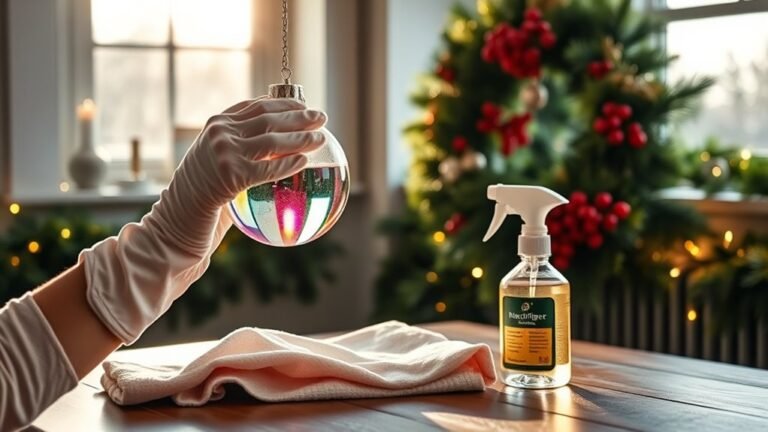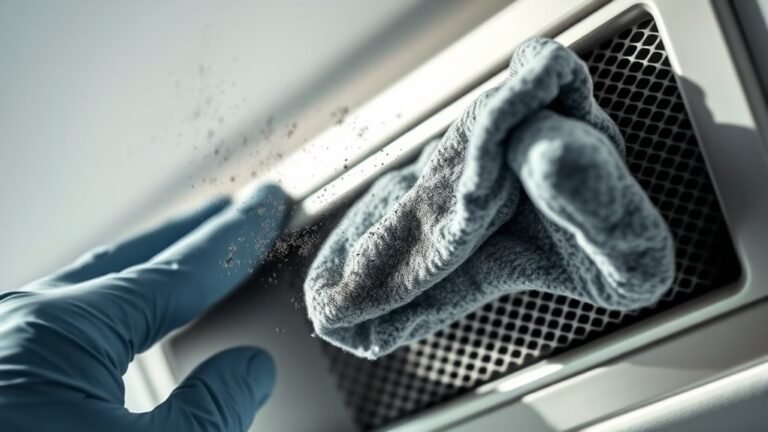How to Remove Stubborn Stains From Stains
To remove stubborn stains, first identify their type—grease, protein, or tannin—then gently blot, avoiding rubbing. Pre-treat with appropriate household items like baking soda for odor, vinegar for general stains, or dish soap for grease. For tougher marks, use enzyme-based cleaners designed for protein stains. Always test products on hidden fabric spots. Acting quickly and following proper steps help prevent stains from setting. Discovering more strategies can improve your stain removal success.
Identifying Different Types of Stains

How do you know which stain remover to use if you can’t identify the type of stain? Effective stain removal starts with accurate stain identification. Begin by examining stain characteristics—consider color, texture, and whether it’s oily, protein-based, or tannin-rich. For example, greasy stains often appear shiny and feel slick, while protein stains like blood or sweat tend to be dull and may darken with heat. Tannin stains, from coffee or wine, are usually colorful and water-soluble. By carefully evaluating these traits, you gain the freedom to choose the right cleaning agent without guesswork. This methodical approach guarantees you tackle stains precisely, saving time and preserving your fabrics. Stain identification isn’t just a step—it’s your key to confident, effective stain removal. Understanding how protein stains bind to fabrics can help you select the best treatment method for removal.
Pre-Treatment Techniques for Tough Stains
Before treating tough stains, you need to identify their type to choose the right solvent. Applying the appropriate solvent directly to the stain helps break it down effectively. Then, use gentle agitation to lift the stain without damaging the fabric. Acting quickly is essential to prevent the stain from setting and becoming permanent, as explained in immediate actions to take.
Identify Stain Type
Why is it important to identify the stain type before treating it? Proper stain identification lets you choose the best pre-treatment method, preventing damage and boosting removal success. Different stains react uniquely to cleaners, so knowing what you’re dealing with saves time and effort.
Here are some common stains and their types:
| Stain Type | Common Stains |
|---|---|
| Protein-Based | Blood, sweat, dairy |
| Oil-Based | Grease, makeup, oil |
| Tannin-Based | Coffee, wine, tea |
Use Appropriate Solvents
Solvents act like targeted agents that break down stubborn stains, making them easier to remove. To choose the right solvent, you need to take into account solvent types and stain compatibility carefully. Here’s what to keep in mind:
- Identify the stain’s composition—oil-based stains respond well to solvents like rubbing alcohol, while water-based stains may require a mild detergent.
- Test the solvent on a small, hidden area to verify it won’t damage the fabric.
- Apply the solvent directly to the stain, allowing it to penetrate and dissolve the stain particles without spreading it further.
Apply Gentle Agitation
Start by gently agitating the stained area to help loosen particles embedded in the fabric. Use your fingers or a soft-bristled brush to perform gentle scrubbing motions, focusing on the stain without damaging the fabric. This step is essential for effective fabric care, as aggressive scrubbing can weaken fibers and worsen the stain. Work patiently, applying enough pressure to break down the stain but not so much that you risk tearing the material. This method enhances the solvent’s ability to penetrate and dissolve stubborn stains. Remember, gentle agitation is about balance—enough movement to free dirt but careful enough to preserve your garment’s integrity. Once complete, rinse lightly and proceed to your next stain removal step for the best results.
Effective Household Ingredients for Stain Removal
You can tackle stubborn stains using common household items like baking soda, vinegar, and lemon juice. These natural ingredients not only break down stains effectively but also reduce chemical exposure. I’ll share practical tips on how to apply each one for the best results. Acting promptly and knowing how to prepare your garment can significantly improve stain removal success.
Common Household Stain Removers
Although commercial stain removers are widely available, many effective solutions can be found right in your kitchen or laundry room. You don’t need to rely on harsh chemicals when common household items work just as well.
Here are three stain removers you can easily use:
- Baking Soda – Sprinkle it on stains to absorb moisture and odors. Let it sit, then brush off before washing.
- Vinegar Solution – Mix equal parts white vinegar and water to break down stains. Apply, let it work for 10 minutes, then rinse.
- Dish Soap – A few drops on greasy stains can lift oils effectively. Gently rub it in before laundering.
Using these items not only saves money but gives you freedom from chemicals while maintaining stain-fighting power.
Natural Ingredient Benefits
Three natural ingredients stand out for their stain-removing benefits: baking soda, vinegar, and dish soap. These natural alternatives offer effective, eco friendly solutions that reduce chemical exposure while tackling stubborn stains. Using them lets you clean freely without compromising the environment or your health.
| Ingredient | Key Benefit | Eco Friendly Aspect |
|---|---|---|
| Baking Soda | Absorbs odors, lifts dirt | Biodegradable, non-toxic |
| Vinegar | Breaks down stains, disinfects | Naturally derived, safe |
| Dish Soap | Cuts grease, loosens grime | Biodegradable formulas available |
| Lemon Juice | Natural bleaching agent | Renewable and biodegradable |
| Salt | Scrubs and preserves fabric | Non-toxic, earth-friendly |
Incorporate these ingredients confidently for a greener, effective stain removal approach.
Application Tips and Tricks
When tackling stubborn stains, knowing how to apply household ingredients properly can make all the difference. Mastering stain removal techniques guarantees you protect fabric care while achieving the best results. Here’s how to apply these ingredients effectively:
- Pre-test the ingredient on a small, hidden fabric area to avoid damage.
- Apply the solution directly to the stain using a clean cloth or sponge, avoiding excessive soaking.
- Gently blot or rub in circular motions, allowing the ingredient to penetrate without harming fibers.
Specialized Products for Stubborn Stains
Several specialized products are designed to tackle stains that resist regular cleaning methods. When you face tough stains, specialty cleaners offer targeted solutions. These products often contain powerful agents formulated to break down specific substances, like grease or ink. Enzyme detergents are particularly effective on organic stains such as blood, sweat, or food. They work by digesting the proteins causing the stain, freeing your fabric without harsh scrubbing. Choosing the right product depends on the stain type and fabric. Always check labels and test on an inconspicuous area to avoid damage. Using these specialized cleaners lets you reclaim your freedom from stubborn stains efficiently, saving time and effort while preserving your items’ integrity. Quick action with the correct cleaning techniques increases the likelihood of successful stain removal.
Step-By-Step Guide to Removing Stains From Fabric

Understanding how to properly remove stains from fabric can save your clothes and upholstery from permanent damage. Effective fabric care starts with prompt action and the right technique. Follow these steps for the best results:
Prompt action and proper technique are key to preventing permanent fabric stains and preserving your clothes and upholstery.
- Identify the stain type – Knowing what caused the stain helps you choose the correct cleaning method, which is essential for stain prevention in the future.
- Blot, don’t rub – Gently blot the stain with a clean cloth to lift excess without spreading it deeper into the fibers.
- Apply appropriate cleaner – Use a fabric-safe stain remover or a mild detergent, test on a hidden area first, then let it sit before washing. Immediate treatment is crucial because different stain types require specific methods to avoid setting the stain permanently.
Tips for Preventing Stains and Maintaining Cleanliness
Although stains can be stubborn, you can greatly reduce their occurrence by adopting simple habits and precautions. Prioritizing stain prevention and cleanliness maintenance helps preserve your belongings and frees you from constant cleaning stress. Here are essential tips:
| Action | Benefit | Frequency |
|---|---|---|
| Immediate cleaning | Prevents stain setting | After spills |
| Use protective covers | Shields surfaces | Continuous |
| Apply stain repellents | Reduces absorption | Monthly |
| Regular vacuuming | Removes dirt early | Weekly |
| Separate laundry loads | Avoids color transfer | Every wash |
Quick cleanup with absorbent materials after spills can prevent stains from becoming stubborn and difficult to remove.
Frequently Asked Questions
Can Professional Cleaning Services Guarantee Stain Removal?
You might think professional cleaning services can guarantee stain removal every time, but stains vary widely. While no one can promise 100% success, these experts use advanced stain removal techniques and professional cleaning methods that vastly improve your chances. They assess your fabric type and stain nature, tailoring treatments accordingly. You get better results and more freedom from worry, knowing they’re maximizing the potential to restore your items effectively.
How Do Climate Conditions Affect Stain Persistence?
You’ll find that climate conditions play a big role in stain persistence. High humidity effects can cause stains to set deeper, making them harder to remove. Temperature fluctuations also matter; heat can accelerate chemical reactions, fixing stains permanently, while cold might slow cleaning efforts. By understanding these factors, you can time your stain removal attempts better, maximizing your chances of success and keeping your freedom to enjoy clean, stain-free fabrics.
Are There Eco-Friendly Methods to Dispose of Stain Removal Chemicals?
Did you know that 75% of households are switching to biodegradable solutions? To dispose of stain removal chemicals eco-friendly, you should avoid pouring them down drains. Instead, collect small amounts and take them to hazardous waste facilities. Natural alternatives, like vinegar or baking soda, reduce chemical waste, letting you enjoy stain-free freedom without harming the planet. By choosing these methods, you’re protecting water sources and promoting a cleaner environment responsibly.
What Fabrics Are Most Resistant to Stain Removal?
When choosing stain resistant fabrics, you’ll find synthetic fibers like polyester and nylon are tough against stains. These materials repel liquids better, making fabric care easier and less time-consuming. Natural fibers such as wool and treated cotton can also resist stains but often need special care. If you want freedom from constant cleaning hassles, opt for these fabrics—they offer durability and simpler maintenance, letting you focus on living without worrying about every spill.
How Often Should Washing Machines Be Cleaned to Prevent Stain Transfer?
Imagine you run laundry weekly but notice dull clothes and leftover stains. To avoid this, you should clean your washing machine every one to three months. Regular washing machine maintenance, like running a hot cycle with vinegar or specialized cleaners, prevents grime buildup that causes stain transfer. Combining this with stain prevention techniques, such as pre-treating garments, guarantees your clothes stay fresh and stain-free, giving you the freedom to wear what you love confidently.






